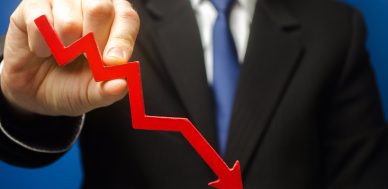This Chart Says S&P 500 Could See Drop of More Than 35%
On March 23, the S&P 500 made a low of $2,191.86. Now the index trades at $3,380.35, meaning it has jumped 54%. Could the S&P 500 go even higher?
If you look at the charts alone, they say there could be a little more upside. However, the downside afterward could be severe and wipe out a lot of the gains that were generated.
Look at the chart below; it plots the S&P 500 on a weekly basis. Pay very close attention to the lines drawn on it.
The pattern you see on this chart is called a megaphone pattern. The idea behind this pattern is very simple: it says prices of S&P 500 stocks are getting volatile.
Chart courtesy of StockCharts.com
Since 2018, moves by the stock market have been volatile. If you look closely at the above chart, you will see that the S&P 500 has moved much higher during this period. But the moves to the downside have been severe.
The first move by the S&P 500 since 2018 was about 11% wide. The second move was more than 18% wide. The third move was about 35% wide.
The fourth move hasn’t happened yet, but assuming that the current pattern remains, the next move could be severely worse than 35%. In fact, it wouldn’t be wrong to say the pattern indicates there could be another bear market ahead.
Long-Term Chart Says S&P 500 Could Drop
This megaphone pattern is playing out on a relatively short-term basis. But look at a longer-term chart below; it plots the S&P 500 on a monthly scale.
Chart courtesy of StockCharts.com
Since late 2009 and early 2010, the S&P 500 has been trading in an upward channel. Understand that channels have an upper bound and a lower bound.
Currently, the index is closing in on its upper bound (around 3,500, or about four percent above the current level). You must ask if it will come back down from 3,500 and touch the lower bound of the channel (assuming it to be around 2,900). This would be a decline of about 17%.
That means the upside is about four percent and the downside is about 17%. From a risk/reward perspective, this is a bad trade if you are a buyer.
Here’s What Investors Can Do
Dear reader, while the mainstream media is loving the rally on the stock market, and even the U.S. president has been patting himself on his back for the massive rally by the S&P 500, I can’t stress this enough: be very careful.
The upside seems very little while the downside could be huge.
If you bought stocks in March of this year, great. But if you expect the S&P 500 to provide similar returns as it did during the past few months, you could be making a very big mistake. For the index to go up another 54%, it would have to go above $5,000.
Know that this figure is very hard to digest, and the index will have a very hard time getting there, given the poor fundamentals and extremely high valuations already.
With all this in mind, in the case there’s a sell-off, the first thing investors could do is place stops on their positions. This would secure the gains they have accumulated since March. And if the market continues to move higher, they wouldn’t miss out on the upside.
